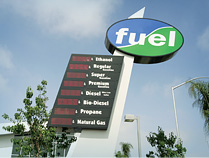About Clean Cities

Our Mission
Clean Cities advances the energy, economic, and environmental security of the United States by supporting local actions to cut petroleum use in transportation.
Our country imported about 27% of the 6.97 billion barrels of petroleum products it consumed in 2014, and more than half of these imports came from outside North America, according to the U.S. Energy Information Administration. Because transportation accounts for about 69% of the more than 18 million barrels per day of U.S. petroleum consumption, reducing our dependence on petroleum-based fuels in this sector supports our economy and our energy security.
Increased economic and energy security aren't the only benefits of reducing petroleum use in transportation. Gasoline- and diesel-powered vehicles are major sources of greenhouse gases, smog-forming compounds, particulate matter, and other air pollutants. Widespread use of alternative fuels and advanced vehicles could reduce the emissions that impact our air quality and public health.
The U.S. Department of Energy's (DOE’s) Clean Cities program advances the nation's economic, environmental, and energy security by supporting local actions to cut petroleum use in transportation. Part of DOE's Vehicle Technologies Office, Clean Cities has saved more than 7.5 billion gallons of petroleum since its inception in 1993.
Who We Are
Nearly 100 local coalitions serve as the foundation of the Clean Cities program by working to cut petroleum use in communities across the country. Clean Cities coalitions are comprised of businesses, fuel providers, vehicle fleets, state and local government agencies, and community organizations. Each coalition is led by an on-the-ground Clean Cities coordinator, who tailors projects and activities to capitalize on the unique opportunities in their communities. Nationwide, nearly 15,000 stakeholders participate in Clean Cities coalitions, and through their collective efforts they are transforming local and regional transportation markets and contributing to Clean Cities’ goals and accomplishments.
What We Do
At the national level, the program develops and promotes partnerships, publications, tools, and other unique resources. At the local level, coalitions leverage these resources to create networks of local stakeholders and provide technical assistance to fleets implementing alternative and renewable fuels, idle-reduction measures, fuel economy improvements, and emerging transportation technologies.
Clean Cities efforts support reduced dependence on petroleum at the local, state, and national levels. Clean Cities activities include:
- Building partnerships with local coalitions of public- and private-sector transportation stakeholders
- Developing unbiased and objective information resources about alternative fuels, advanced vehicles, and other strategies to cut petroleum use
- Advancing interactive, data-driven online tools to help stakeholders evaluate options and achieve goals
- Collecting and sharing best practices, data, and lessons learned to inform choices and build a strong national network
- Providing technical assistance to help fleets deploy alternative fuels, advanced vehicles, and idle-reduction measures
- Working with industry partners and fleets to identify and address technology barriers
- Empowering local decision makers to successfully implement the best petroleum reduction strategy for their circumstance
- Seeding local alternative fuels markets through projects that deploy vehicles and fueling infrastructure.
Why We're Here
Clean Cities dates back to the Alternative Motor Fuels Act of 1988 and the Clean Air Act Amendments of 1990. These laws, which encouraged the production and use of alternative fuel vehicles (AFVs) and the reduction of vehicle emissions, led to the creation of the Alternative Fuels Data Center (AFDC) in 1991. The AFDC's mission was to collect, analyze, and distribute data used to evaluate alternative fuels and vehicles.
In 1992, the enactment of the Energy Policy Act of 1992 (EPAct) required certain vehicle fleets to acquire AFVs. Subsequently, DOE created Clean Cities in 1993 to provide informational, technical, and financial resources to EPAct-regulated fleets and voluntary adopters of alternative fuels and vehicles.
The AFDC became and continues to be the clearinghouse for these resources. Its sister website, FuelEconomy.gov, provides consumers with information on fuel economy, emissions, and energy impact of light-duty vehicles, based on vehicle data from the U.S. Environmental Protection Agency. The site also provides tips for drivers on maximizing fuel efficiency. FuelEconomy.gov was created in response to DOE's requirement under the 1975 Energy Policy and Conservation Act to publish and distribute an annual fuel economy guide for consumers.
